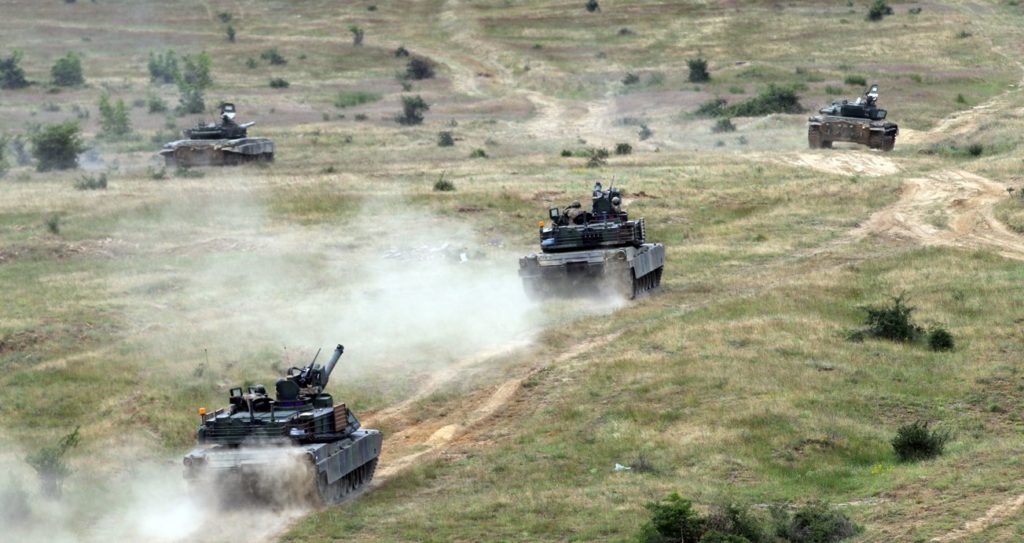On October 12, Breaking Defense released an article entitled “Robot Hover Tanks With Ray Guns? Army Looks To Replace M1“:
“It doesn’t have to be a tank, it just has to be decisive and lethal,” Brig. Gen. Richard Ross Coffman answered. “If that is run by a flux capacitor, hovers, and has a ray gun — and we can make it run at a reasonable cost — we’ll look at it.”
By 2023, the Army will decide whether or not to move ahead with a replacement for the M1 Abrams heavy tank. “Anything’s on the table,” said the service’s director for armored vehicle modernization.
Define “anything,” I asked. Are we talking Imperial Walkers from Star Wars? Little robots carrying big missiles?
“It doesn’t have to be a tank, it just has to be decisive and lethal,” Brig. Gen. Richard Ross Coffman answered. “If that is run by a flux capacitor, hovers, and has a ray gun — and we can make it run at a reasonable cost — we’ll look at it.”
That “reasonable cost” criterion, sadly, rules out laser-shooting hover tanks, but behind Coffman’s jocularity is a deadly serious point: The Army wants industry to imagine a wide range of possibilities for a new way to deliver high-powered direct fire. (Indirect fire, at targets over the horizon, belongs to a different modernization team, which is exploring a 1,000-mile supergun). The key thing is to apply maximum killing power at the crucial point in combat, not how you do it. If you have a technically feasible proposal, it sounds like they’ll at least take a look.
“We don’t want to stifle any initiative based on some preset notion of, ‘it has to be tank, it has to have 120 mm or 105 (cannon),’” Coffman told an industry audience at the Association of the US Army conference. “We want options.”
New Armor, Active Protection, & Robotics
The Army’s program manager for the Next Generation Combat Vehicle (NGCV), Col. James Schirmer, offered some more down-to-earth details in a later briefing at AUSA.
In his “personal opinion,” the colonel caveated, “I believe that a complete replacement of the Abrams tank wouldn’t make sense unless we have a breakthrough in one of three technology areas”:
Active Protection against solid shot: The Army is already rushing to equip its existing M1s with the Israeli-made Trophy Active Protection System, which uses radar to detect incoming anti-tank weapons and mini-missiles to shoot them down.

US Army M1 Abrams tank with Trophy Active Protection Systems (APS) and improved protection for machinegun operator.
But there’s a basic problem with Trophy and the other Active Protection Systems that the Army is exploring for other vehicles. They can defeat high-explosiverockets and missiles by preventing them from exploding properly — by prematurely detonating the warhead, smashing it apart before it detonates, or even warping it so the detonation doesn’t produce a blast wave focused enough to penetrate armor. But, while many companies are trying, no one’s yet proven the ability to defeat a solid metal shot. Why? Because these “kinetic energy penetrators” don’t have any explosive detonation to interfere with, relying on brute mass and high velocity instead.
Now, the high-explosive warheads that APS can deal with are much more common, because they can be fired by low-velocity weapons mounted on light vehicles or even individual soldiers (e.g. the RPG). A kinetic penetrator has to have so much mass, moving at such high speed, that only a tank’s main gun can fire one — but whatever replaces the Abrams will have to fight tanks, even if it’s not a tank itself.
One promising possibility is to use modern anti-tank technology against itself. While old-school kinetic penetrators look like giant bullets, the most powerful ones are dart-like “long-rod penetrators” with a needle nose to help them penetrate armor. It’s easier to warp, break, or deflect the penetrator rod than the solid shell behind it, which means an Active Protection System that at least reduces the effectiveness of long-rod penetrators is a near-term possibility. Such an APS wouldn’t replace traditional armor plate altogether, but it would dramatically reduce the weight of armor that a vehicle needed to carry.

BAE’s Armed Robotic Combat Vehicle (ARCV), originally developed for the Future Combat Systems (FCS) program
Robotic Tanks: Improving armor materials or active protection systems is about ensuring your vehicle survives. But if your vehicle doesn’t have any humans in it, maybe you don’t care. Now, even if you gave a robot tank the same thickness of armor as the M1 Abrams, the robot would be lighter, because it would be smaller, not needing any interior volume for a crew. (Circuit boards are more compact than people). But you could also create a semi-expendable armored vehicle with a powerful weapon and a minimum of armor.
In fact, before the Future Combat Systems fiasco of 2003-2009, the Army was studying a concept for a disaggregated tank, with the main weapon on one robot, sensors on other robots, and a human crew remote-controlling everything from a safe distance. But this vision ran aground on the limitations of artificial intelligenceand wireless networks.
Even today, AI still struggles to navigate rough terrain and distinguish physical objects, so a human operator would have to monitor it constantly over a real-time video feed. Some contractors have gotten such a remote control system to work over a 500 or even 700 meter (1,600 to 2,300 feet) between robot and human, Brig. Gen. Coffman said, — but a tactically useful system would need a range of roughly three kilometers (1.9 miles). The alternative is to make the robot smarter so the human doesn’t need to monitor it constantly, but AI technology just isn’t there yet.
To get an unmanned vehicle — whether remote-controlled or truly autonomous — to “fight as effectively as a manned tank does today….that’s a pretty tall order,” Schirmer said. “It’s not impossible but I think it’s going to take a while to get there.”
Fortunately, “we have time,” Coffman told the industry audience, because the go/no-go decision to start development on the M1 replacement isn’t until 2023. “We have time to develop options for our leaders,” he emphasized, and more time makes more options feasible.
“Everyone always asks me, you’re building the next tank,” Coffman told reporters after the briefing. “No, I’m building something that’s going to be decisively lethal on the battlefield; I don’t care what that looks like.”
“As a third-generation tanker,” Coffman continued, “I know what a tank is, I know what it can do.” But for the Army’s future decisive lethality vehicle, he said, “if it’s a tank, it’s a tank. if it’s not a tank, I don’t care.”











Getting ideas from the Star war movies. Hollywood can throw you in a spin to chase white elephants.
and russia in 2040 will copy the new american tanks :DDDD
As for the “kinetic shot,” the word you are searching for is sabot round. The Trophy system works by sending a big shotgun blast at a rocket but with the dense shot of a depleted uranium shell that wound do much even if it hits. It is a minor game change, though, because rockets used to be the easiest way for light vehicles or infantry to take out tanks and now rockets are less useful.
Altogether, this is the Army planning ahead because as you see their are so many modern systems and materials that in a decade or two we’ll need to design a new tank around these systems.
Russian Afghanit is supposed to be effective against sabot shots, even though explosive brick armour can cut a few inches of the sabot spike, taking the needle out or blunting it.
I smell a new future American lemon in the making. The American way of weapons design seems to be to come up with a radical new concept, get everybody excited, throw lots of money at it, run into major problems, throw more money at it, in which case it eventually works or it doesn’t. In which case start all over again. In the past there were usually enough defense companies so if a big project failed an alternative could usually be chosen and developed instead. Nowadays there’s basically just Lockheed-Martin and Boeing. And once the big giant lemon fails, the other company usually has nothing left anymore as its involved with a big giant lemon of its own.
Meanwhile the Russian way of weapons design seems to be to take an existing design and tweak it further and further, evolution instead of revolution. And while the Russians will come up with revolutionary new designs of their own, they never throw something away old. Western observers will probably scoff and say the Russians keep on tweaking their old legacy designs. But it works, and often for a fraction of the money that Western designs cost.
“You can always count on Americans to do the right thing – after they’ve tried everything else.” Winston Churchill
I’m sure the “Hover Tank” will be just another profitable piece of crap (i.e., F35) that benefits the MIC with funds partly disbursed to the SSP.
“That “reasonable cost” criterion, sadly, rules out laser-shooting hover tanks”
Actually, it pretty much rules out a wooden stick.
Great Comments- What are your ideas? The US Army is trying to break new ground here. Looking for lemonade not lemons Barda_Papa. Everything is on the table. So provide creative and innovative thoughts to help. We are listening.
I just like the helpful information you provide in your articles
This was beautiful Admin. Thank you for your reflections.
I just like the helpful information you provide in your articles
I like the efforts you have put in this, regards for all the great content.
I like the efforts you have put in this, regards for all the great content.
This was beautiful Admin. Thank you for your reflections.
Great information shared.. really enjoyed reading this post thank you author for sharing this post .. appreciated
This was beautiful Admin. Thank you for your reflections.
إذا كنت تبحث عن أفضل تجربة تسوق في عالم الفيب والمعسلات، فإن أملاح النيكوتين هو خيارك الأمثل. نحن نقدم منتجات عالية الجودة مثل Buy vape online Saudi Arabia ومعسلات، مع تشكيلة واسعة تناسب جميع الأذواق. يمكنك العثور على nicotine salts Saudi وتجارة فيب الرياض بسهولة وبأسعار تنافسية. خدماتنا تشمل nicotine salts vape السعودية وJustSmook vape Riyadh لتضمن لك الراحة والتسوق من المنزل. لا تفوت فرصة الاستمتاع بـ اشترِ سجائر إلكترونية عبر الإنترنت في السعودية اليوم. سحبة vapes Saudi Arabia طلب فيب اونلاين الرياض ووصله للبيت nicotine salts Saudi Nicotine salts vape Riyadh shop disposable vape Saudi Arabia vape متجر الرياض
Hidden Gems Around the World Worth Exploring
Makaleniz açıklayıcı yararlı anlaşılır olmuş ellerinize sağlık
Great information shared.. really enjoyed reading this post thank you author for sharing this post .. appreciated
Daha önce araştırıp pek Türkçe kaynak bulamadığım sorundu Elinize sağlık eminim arayan çok kişi vardır.
Gerçekten detaylı ve güzel anlatım olmuş, Elinize sağlık hocam.
Emeğinize sağlık, bilgilendirmeler için teşekkür ederim.
gerçekten çok yararlı bi konu teşekkürler
Daha önce araştırıp pek Türkçe kaynak bulamadığım sorundu Elinize sağlık eminim arayan çok kişi vardır.
I just like the helpful information you provide in your articles
Nice helpful perfect perfect superb random great awesome.